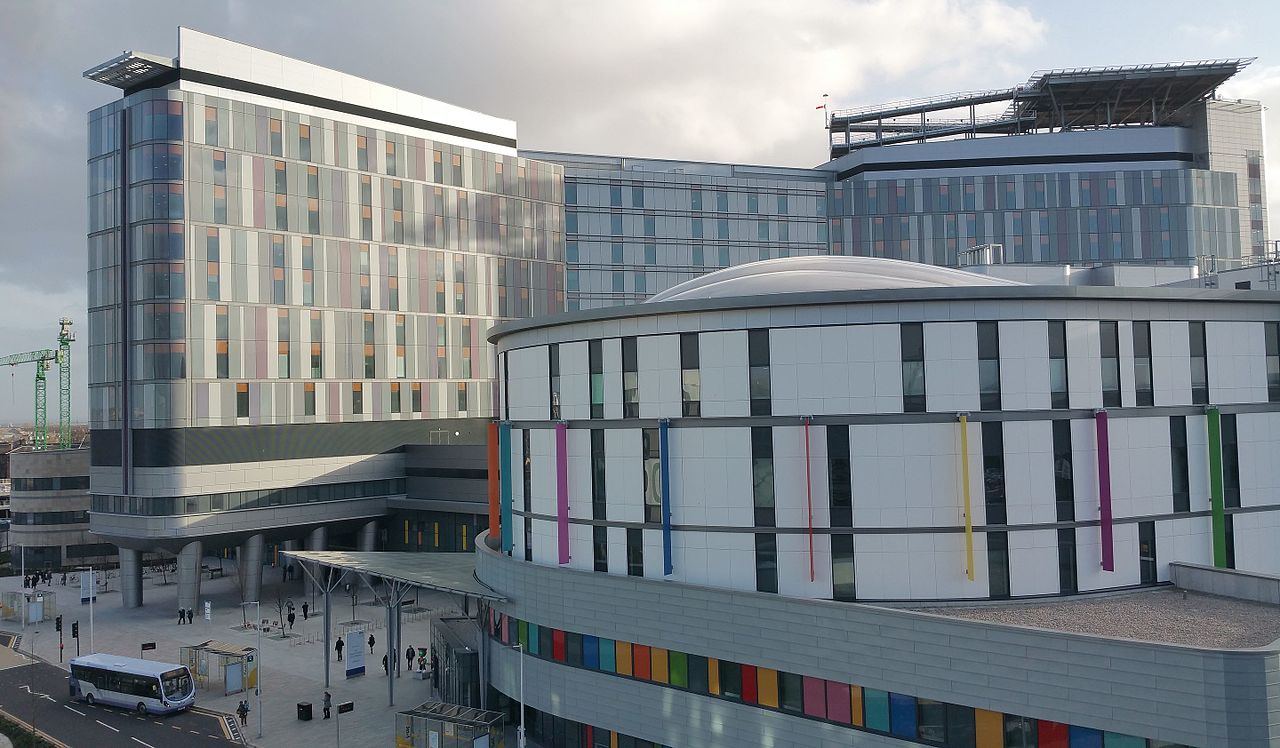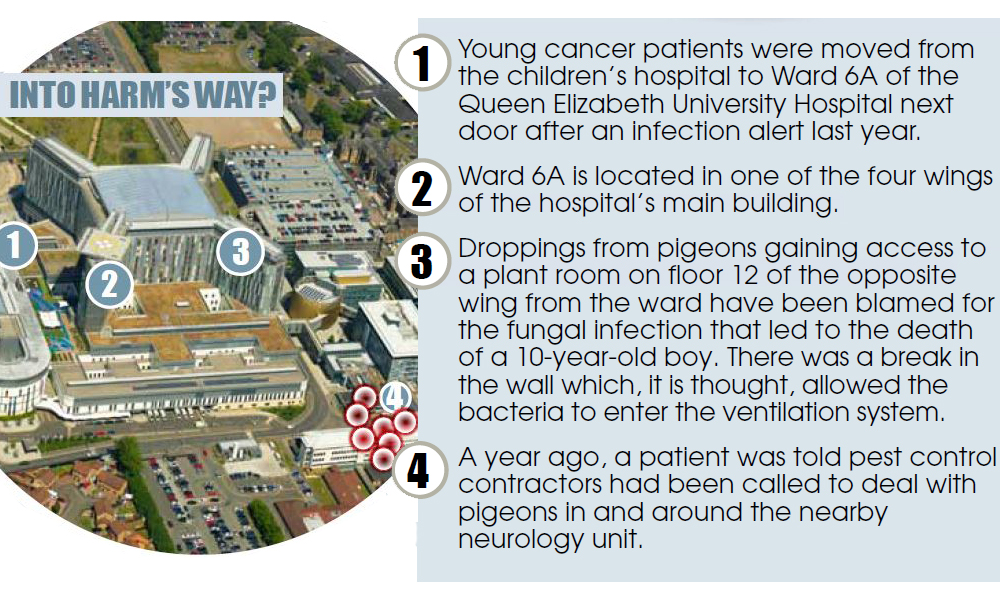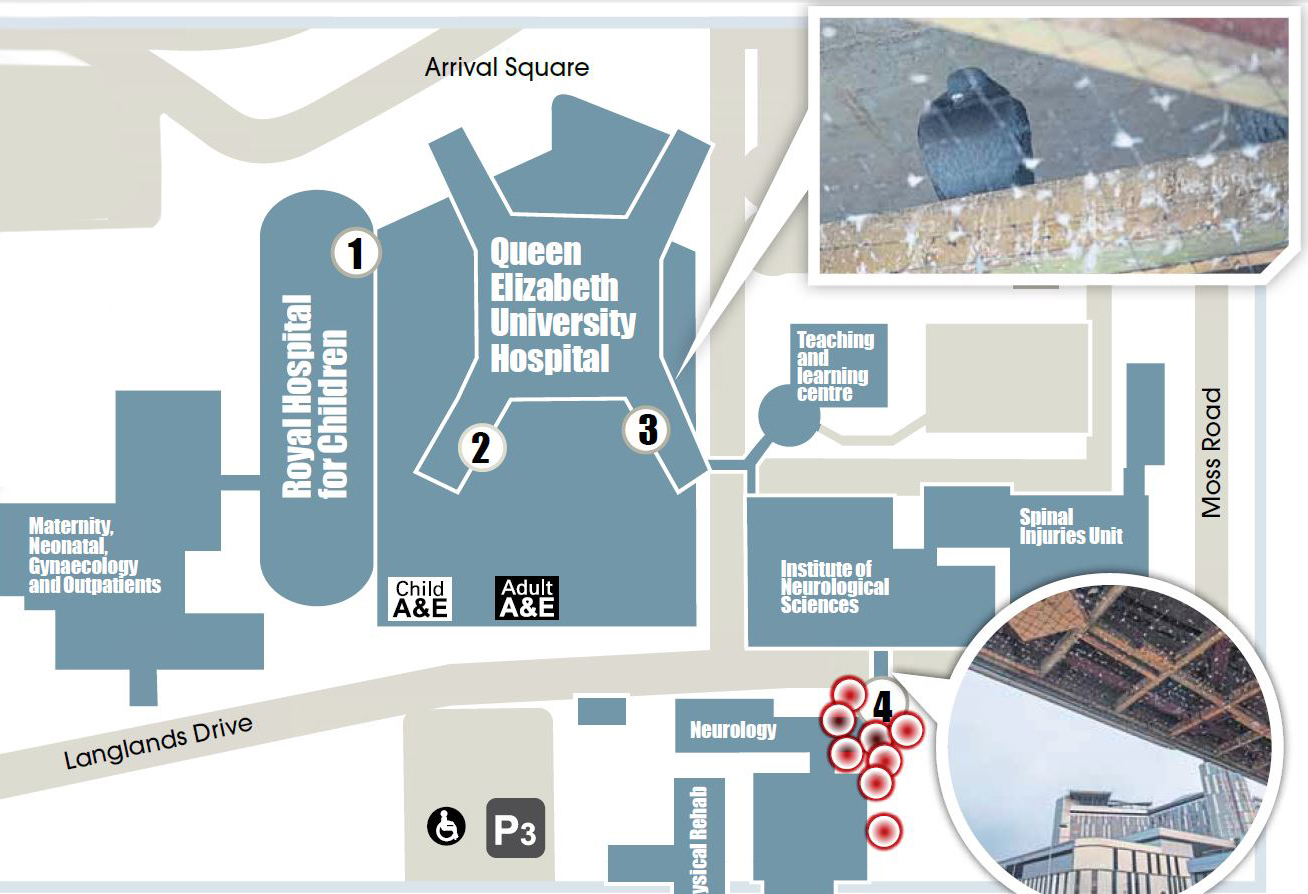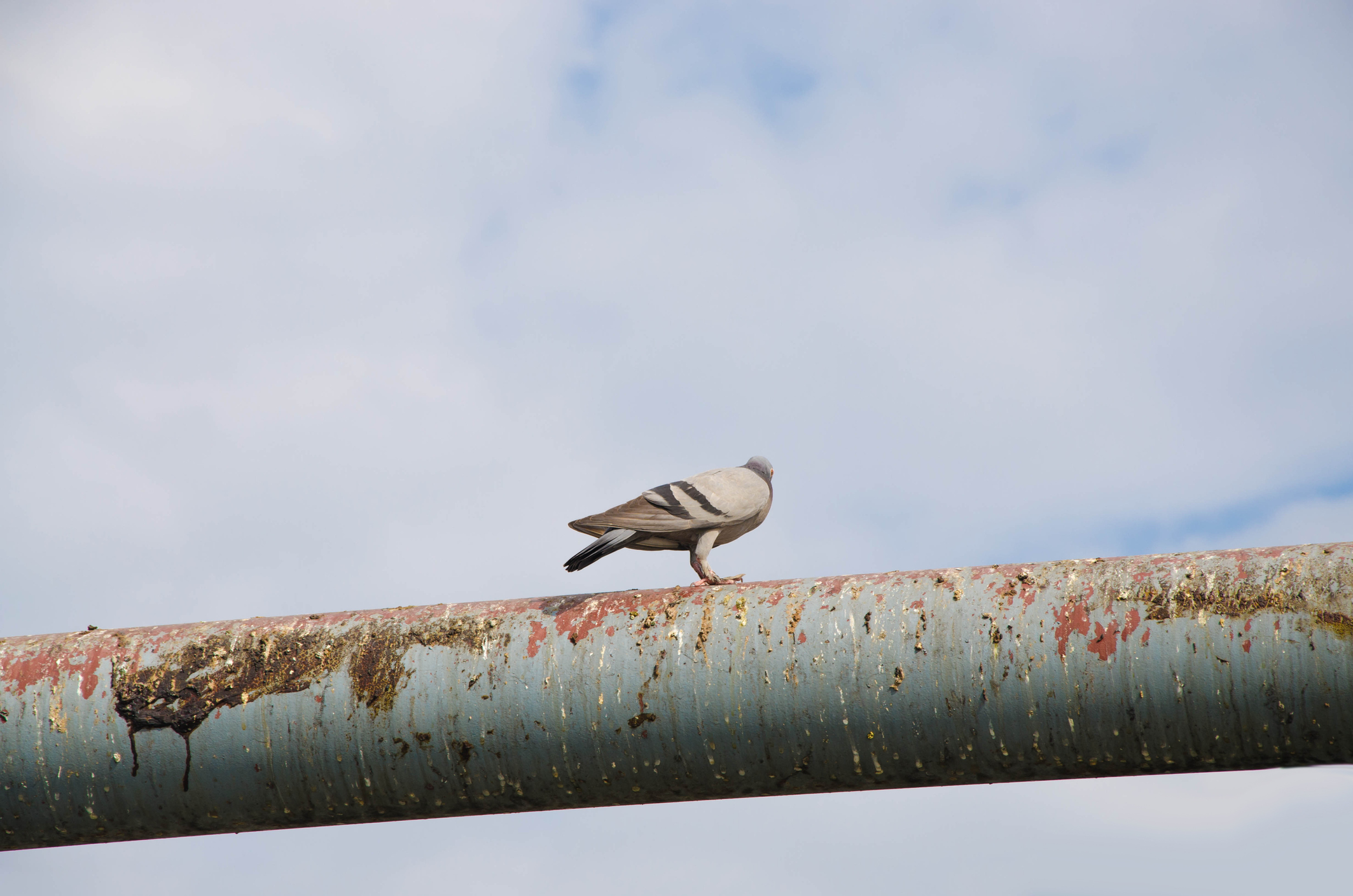
FAMILIES of young cancer patients at the hospital where a 10-year-old boy died after being infected by pigeon droppings have revealed a climate of fear, confusion and official secrecy in the wards.
Relatives of the children, some of the illest youngsters in the country, said bosses at the Queen Elizabeth University Hospital in Glasgow, have failed to calm their fears in the week since it emerged the boy had died of the infection while being treated for cancer.
They described “chaos and secrecy” after sick youngsters were moved from the children’s hospital next door into adult wards because of a previous, unrelated infection alert and then moved again because of the new infection risk caused by pigeon droppings in a plant room.
One of Scotland’s leading experts yesterday said the initial move inadvertently moved children into harm’s way. Greater Glasgow and Clyde health board revealed last Friday night that two patients, including the young cancer sufferer, had contracted the fungal infection four weeks ago.
The board has since faced heavy criticised for the delay in informing patients, staff and the public about the infection, how it happened, and what had been done to control it.
And the flagship £842 million super hospital is now minimising the admission of cancer patients as management battle to reassure the public and patients as a series of official inquiries get under way.
Families of young cancer patients said they were being given no more information on the ward after the news broke last weekend.
One relative said: “We were never told anything by the hospital. We heard from the media.
“When we asked the hospital what was going on, we were handed a press release.”
They said several families had “lost confidence in the way this hospital is run”, adding: “This is one of the most vulnerable times in our lives. We were frantic, desperate for information and reassurance but didn’t get it.
“Parents felt they were in the way, instead of feeling secure when their children were desperately ill. We are scared. The parents are in uproar. Many are in for months with children undergoing treatment for leukaemia.
“That can involve a lengthy time in isolation where the child cannot be moved out or come in contact with others because their immune system is seriously low and the simplest of bugs could kill them.
“All we can do is hope for the best. Morale among the parents is low at a time when they need as much support and reassurance as possible.”
They described asking for meetings with managers after news of the infection broke last Friday night.


A relative of another child being treated in the wards affected said: “We wanted meetings with the medical teams, infection control and head of the hospital but two days later they sent the oncologist and the head of microbiology.
“They told us the children were never put in danger as you had to be very ill for this fungus to carry a risk. But many of the children are clearly very ill. You can imagine how we all feel. We have children fighting to survive cancer and there is a bug that we knew nothing about which has already killed one of them.
“Before that we were juggling beds with children having to be fitted into adult cancer wards, where spaces were already short.
“Before we knew what was going on behind the scenes, we were told the children would be on anti-fungal treatment which they would not normally be on and which was not part of the meds or protocol for treating children with cancer.
“A doctor told us this was because of something to do with cladding and other factors.
“We are worried about the long-term effects of any other drugs when the children are already seriously ill but we have no choice.
“The fungus cryptococcus has proved to be lethal and we have no choice but to agree.”
The families echoed criticism of the health board’s delay in announcing the infection, and the failure to reveal both patients infected had died was criticised.
Inside Ward 6: Patient says they raised the alarm a year ago, and asks why nothing was done until now – click here to read more
Last week, reporters say they were initially told the patients involved were responding to treatment, although the hospital denies this, and, on Saturday, The Sunday Post was told that it would be wrong to suggest a child had died. The death of the 10-year-old boy linked to the infection was confirmed the next day by the Scottish Government.
The child cancer patients had been moved from the Schiehallion ward, in the Royal Hospital for Children, in September, after a problem with the water supply in that building.
The children were moved to the adjacent Queen Elizabeth Hospital, with most of them placed in Ward 6A and some in other rooms throughout the 1,677-bed building. It has been claimed that Ward 6A did not have the special air filters which would have protected the young patients from airborne infection.
Then early last week, after news of the young boy’s death broke, the children were moved again.
This time they were moved to the Clinical Decisions Unit, an 18-room unit also in the QEUH, which does have specialist HEPA air filters in every room.
Miles Briggs MSP, the shadow cabinet secretary for health, said: “The infection control procedures which saw children moved from a ward with bacteria in the water to an area where exposure to air contaminated with cryptococcus is deeply concerning.
“Anyone using the Queen Elizabeth deserves to do so safely and securely. However, that confidence will have been shaken in light of recent events.”
Health Secretary Jeane Freeman launched an independent review of the hospital. She added that those involved in the design, construction, commissioning and maintenance of the hospital will be expected to “input into the review”.
The Crown Office has confirmed it is also investigation saying: “The Procurator Fiscal received a report in connection with the death of a 10-year-old boy at the Queen Elizabeth University Hospital in December 2018. The investigation is ongoing and the family will be kept updated in relation to any significant developments.”
Inside Ward 6: Expert says moving children to protect them may have put them in the way of greater risk – click here to read more
The Health and Safety Executive said that they had also been in touch with the health board and were “making inquiries”.
Meanwhile, Irenee O’Neill, general secretary of trade union the Independent Federation of Nursing in Scotland, said pigeons have caused issues at the site – formerly the Southern General – for decades.
“An adolescent unit garden was rendered unusable by patients because of the problem with pigeons,” she said. “They couldn’t let the patients into the garden.
“It is near the Shieldhall Wastewater Treatment works, a sewage works. Investigations need to be carried out to see if there is a relationship here. We then have to question whether this was the right site to build the hospital.”
Hospital designers IBI Group said they have “not yet been contacted” but stand ready to “fully assist” the Health Secretary and the hospital management.
Project partners Brookfield Multiplex, which built the hospital, did not respond to our request for a comment.
Greater Glasgow and Clyde Health Board said: “We continue to carry out a detailed investigation into this incident and the Cabinet Secretary’s announced review with external expert input will report publicly on the outcome of specific details when complete.
“We are totally committed to patient safety, patient confidentiality and to open and honest communication with patients and relatives of patients.”
Now cancer patients sent to Edinburgh
NHS chiefs in Glasgow have sent some cancer patients to Edinburgh hospitals while they deal with the potentially fatal bacteria caused by pigeon droppings.
The Greater Glasgow and Clyde health board said they are trying to “minimise admissions” to cancer wards at the Queen Elizabeth University Hospital while they refurbish showers and carry out air tests.
Cryptococcus bacteria travelled to wards from a machinery room on the twelfth floor plastered with pigeon droppings. Children with cancer have been treated in ward 6A in the Arran wing of the adult hospital after a water-borne bacteria unrelated to pigeon droppings shut the Schiehallion cancer unit in the children’s hospital last March.
Patients undergoing treatment for cancer can be immunocompromised, meaning they are more susceptible to deadly infections.
NHS Greater Glasgow and Clyde told the Post cancer treatment units remain open but they have tried to limit the number of patients admitted.
A spokeswoman for the health board said: “None of our cancer treatment units are closed.”
The Dangers

An expert in pigeon control yesterday said the dangers of having ill patients near the birds is impossible to underestimate.
Erick Wolf, whose firm Innolytics produces birth control for feral pigeons, said it is important for hospitals to manage their on-site bird population.
Greater Glasgow and Clyde Health Board had, until last week, insisted the pigeons were not a great risk to health. But Mr Wolf said: “Critically ill patients should not be around pigeons or their faeces. It is a dangerous thing. There are 60 different diseases that pigeons can transmit in addition to all the different parasites that they carry.”

Enjoy the convenience of having The Sunday Post delivered as a digital ePaper straight to your smartphone, tablet or computer.
Subscribe for only £5.49 a month and enjoy all the benefits of the printed paper as a digital replica.
Subscribe